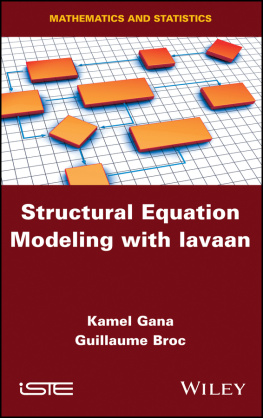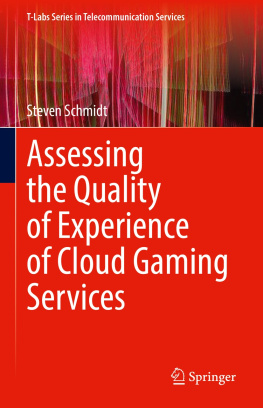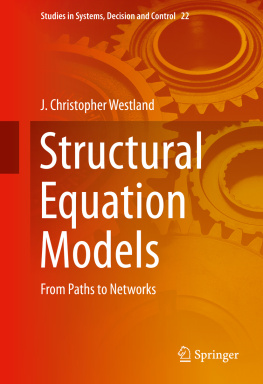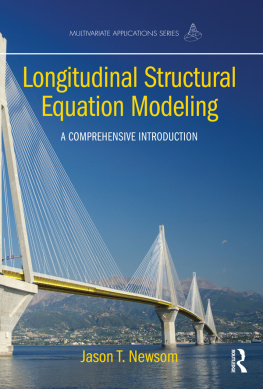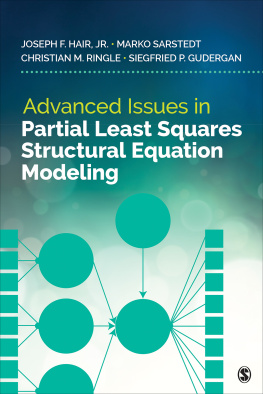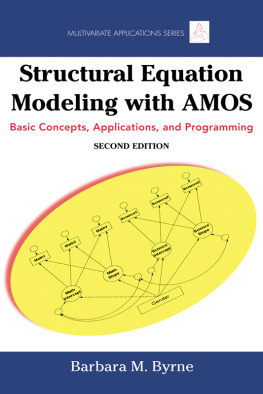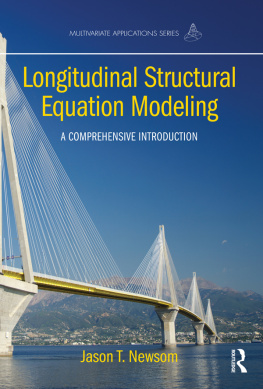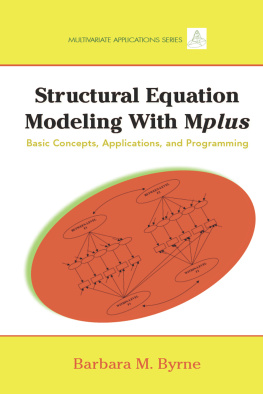Broc Guillaume - Structural equation modeling with lavaan
Here you can read online Broc Guillaume - Structural equation modeling with lavaan full text of the book (entire story) in english for free. Download pdf and epub, get meaning, cover and reviews about this ebook. City: London;Hoboken;NJ, year: 2019, publisher: ISTE;John Wiley & Sons, genre: Romance novel. Description of the work, (preface) as well as reviews are available. Best literature library LitArk.com created for fans of good reading and offers a wide selection of genres:
Romance novel
Science fiction
Adventure
Detective
Science
History
Home and family
Prose
Art
Politics
Computer
Non-fiction
Religion
Business
Children
Humor
Choose a favorite category and find really read worthwhile books. Enjoy immersion in the world of imagination, feel the emotions of the characters or learn something new for yourself, make an fascinating discovery.
- Book:Structural equation modeling with lavaan
- Author:
- Publisher:ISTE;John Wiley & Sons
- Genre:
- Year:2019
- City:London;Hoboken;NJ
- Rating:3 / 5
- Favourites:Add to favourites
- Your mark:
- 60
- 1
- 2
- 3
- 4
- 5
Structural equation modeling with lavaan: summary, description and annotation
We offer to read an annotation, description, summary or preface (depends on what the author of the book "Structural equation modeling with lavaan" wrote himself). If you haven't found the necessary information about the book — write in the comments, we will try to find it.
Structural equation modeling with lavaan — read online for free the complete book (whole text) full work
Below is the text of the book, divided by pages. System saving the place of the last page read, allows you to conveniently read the book "Structural equation modeling with lavaan" online for free, without having to search again every time where you left off. Put a bookmark, and you can go to the page where you finished reading at any time.
Font size:
Interval:
Bookmark:

Kamel Gana
Guillaume Broc

First published 2019 in Great Britain and the United States by ISTE Ltd and John Wiley & Sons, Inc.
Apart from any fair dealing for the purposes of research or private study, or criticism or review, as permitted under the Copyright, Designs and Patents Act 1988, this publication may only be reproduced, stored or transmitted, in any form or by any means, with the prior permission in writing of the publishers, or in the case of reprographic reproduction in accordance with the terms and licenses issued by the CLA. Enquiries concerning reproduction outside these terms should be sent to the publishers at the undermentioned address:
ISTE Ltd
27-37 St Georges Road
London SW19 4EU
UK
www.iste.co.uk
John Wiley & Sons, Inc.
111 River Street
Hoboken, NJ 07030
USA
www.wiley.com
ISTE Ltd 2019
The rights of Kamel Gana and Guillaume Broc to be identified as the authors of this work have been asserted by them in accordance with the Copyright, Designs and Patents Act 1988.
Library of Congress Control Number: 2018956892
British Library Cataloguing-in-Publication Data
A CIP record for this book is available from the British Library
ISBN 978-1-78630-369-1
The core content of this book was written 20 years ago, when I began giving my first courses on structural equation modeling at the Franois Rabelais University in Tours, France. Having never been left pending, the manuscript has been constantly updated for the needs of my university courses and numerous introductory workshops to SEM that I was conducting in various foreign universities. These courses and workshops were both an introduction to the statistical tool and an adoption of a software without which this tool would be obscure, abstract and disembodied. To put it directly and bluntly, any introduction to structural equation modeling (SEM) compulsorily includes adopting a SEM software. Among LISREL, Amos, EQS, Mplus Sepath/Statistica, and Calis/SAS, there is no dearth of options. These commercial programs no doubt helped in demystifying structural equation modeling and have thus given it an actual popularity that continues to grow.
Writing a book, in this case a practical handbook of structural equation modeling, requires introducing one or more of these commercial software that are admittedly quite expensive. That is where the problem lies. Not that they do not deserve it, but picking one is inevitably advertising that software. I cannot and will not consent to this. Moreover, access to these commercial software remains, for many students and young researchers, an obstacle and constraint that is often insurmountable. I have often experienced the challenge of teaching SEM in African universities where it was impossible to have SEM commercial software. I happened to use a restricted student version of a commercial program to demonstrate in my class.
When R, free open-source software, was developed, the situation changed. R is made of packages dedicated to all kinds of data analysis and processing. The lavaan package, provided by Rosseel [ROS 12], is dedicated to SEM. It achieved immediate success as it has all the features proposed by commercial software, and it offers such a disconcerting ease of use. As with any statistical tool, practice remains the best way to master SEM. There is no better way to do this than by having software at hand. R and lavaan have changed our way of teaching statistical tools as well as the way in which students can become familiarized with, adapt, and use them. Our level of demand on them changes as the students' view of these tools evolves. Understanding, learning, and especially practicing without any limits (apart from that of having a computer): this is what R and its lavaan package offer to students. This book certainly contributes to it.
Without the impetus and the decisive and meaningful contribution of Guillaume Broc, author of the book Stats faciles avec R (De Boeck), this manual would not have seen the light of day. We share the following belief: access to science and its tools must become popular and be available to everyone. We think that this manual, devoted to structural equation modeling with lavaan, fully contributes to this purpose.
It is because this book aims to be a didactic handbook and a practical introduction to SEM meant for students and users who do not necessarily need complex mathematical formulae to adopt this tool and be able to use it wisely, that we submitted the first draft to some novice students in SEM in order to assess its clarity and comprehensibility. Their careful reading and their judicious and pertinent comments allowed for a substantial improvement of this manual. They are very much thanked for this. In fact, they are fully involved in this project. However, we retain and accept full responsibility for mistakes, shortcomings, or inadequacies that may be present in this manual.
Kamel GANA
October 2018
The time of disjointed and mobile hypotheses is long past, as is the time of isolated and curious experiments.
From now on, the hypothesis is synthesis.
Gaston Bachelard Le Nouvel Esprit scientifique, 1934
There is science only when there is measurement.
Henri Piron, 1975
Predicting and explaining phenomena based on non-experimental observations is a major methodological and epistemological challenge for social sciences. Going from a purely descriptive approach to an explanatory approach requires a suitable, sound theoretical corpus as well as appropriate methodological and statistical tools. It is because it is part of an already outlined perspective that structural equation modeling constitutes an important step in the methodological and epistemological evolution of psychology, and not just one of the all too frequent fads in the history of our discipline, wrote Reuchlin ([REU 95] p. 212). The point aptly described by Reuchlin applies to several other disciplines in the human and social sciences.
Since its beginning, there have been two types of major actors who have worked with structural equation modeling (SEM), sometimes in parallel to its development: those who were/are in a process of demanding, thorough, and innovative application of the method to their field of study, and those who were/are in a process of development and refinement of the method itself. The second group is usually comprised of statisticians (mathematicians, psychology psychostatisticians, etc.), whereas the first group is usually comprised of data analysts. While willingly categorizing themselves as data analysts, the authors of this book recognize the importance of the statistical prerequisites necessary for the demanding and efficient use of any data analysis tool.
This manual is a didactic book presenting the basics of a technique for beginners who wish to gradually learn structural equation modeling and make use of its flexibility, opportunities, and upgrades and extenxions. And it is by putting ourselves in the shoes of a user with a limited statistical background that we have undertaken this task. We also thought of those who are angry with statistics, and who, more than others, might be swayed by the beautiful diagrams and goodness-of-fit indices that abound in the world of SEM. We would be proud if they considered the undoubtedly partial introduction to SEM we give here as insufficient. As for those who find the use of mathematics in humain and social sciences unappealing, those who have never been convinced by the utility of quantitative methods in these sciences, it is likely that, no matter what we do, they will remain so forever. This manual will not concern them It is hardly useful to focus on the fact that using these methods does not mean conceiving the social world or psychological phenomena as necessarily computable and mathematically formalizable systems. Such a debate has lost many a time to the epistemological and methodological evolution of these sciences. This debate is pointless
Next pageFont size:
Interval:
Bookmark:
Similar books «Structural equation modeling with lavaan»
Look at similar books to Structural equation modeling with lavaan. We have selected literature similar in name and meaning in the hope of providing readers with more options to find new, interesting, not yet read works.
Discussion, reviews of the book Structural equation modeling with lavaan and just readers' own opinions. Leave your comments, write what you think about the work, its meaning or the main characters. Specify what exactly you liked and what you didn't like, and why you think so.

